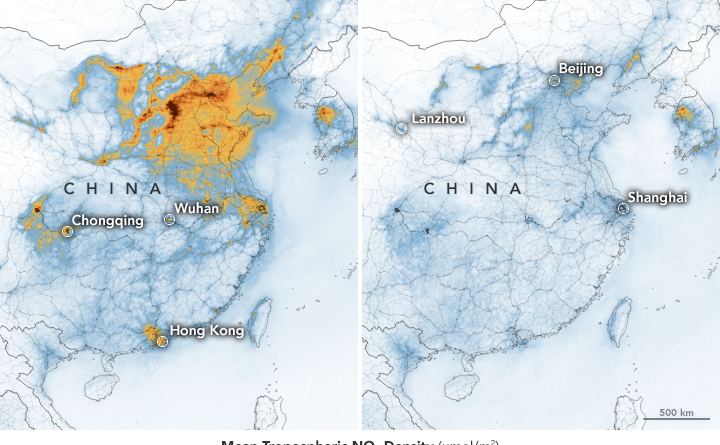Improvements Seen in Global Air Pollution Levels from COVID-19 Efforts
Alyssa Futa
Staff Writer and Communications Liaison
As countries and cities around the world begin to take measures to contain and prevent the spread of COVID-19, the environmental impact from the virus has become apparent. As of April 9, India has been on lockdown for 17 days, which prevents the citizens from traveling by car, factories from operating, and the cancellation of flights. For the first time in nearly 30 years, the Himalayan mountains have become visible from various parts of the country due to a significant decrease in air pollution. According to CNN, “Delhi saw up to a 44 percent reduction in PM10 (a particulate matter) air pollution levels on the first day of its restrictions.”
Other cities and countries with previously high air pollution rates also experienced significant drops in emissions. New York City experienced a 50 percent decrease in pollution levels due to preventative measures relating to COVID-19, and according to China’s Ministry of Ecology and Environment, “The proportion of days with ‘good quality air’ was up 11.4 percent compared with the same time last year in 337 cities across China” says BBC.
Similar to the UK and Spain, satellite images over Northern Italy show a decrease in nitrogen dioxide emissions, a harmful gas.
While this may show a glimpse of optimism, the link between air pollution and COVID-19 doesn’t stop there. Research done by the Harvard University T.H. Chan School of Public Health has found that individuals from areas that experience chronically higher levels of air pollution are more likely to die from COVID-19 than those from areas with cleaner air. Researchers also found that the presence of a greater level of PM2.5, a tiny, yet dangerous air particle released by air pollution, was linked to higher mortality rates linked to COVID-19.
These findings are of particular interest and importance for those who come from lower-income communities, as these are traditionally those that face exposure to greater levels of air pollution. According to Dr. John R. Balmes, a spokesman for the American Lung Association and a professor of medicine at the University of California, San Francisco, in his interview with The New York Times, “We need to make sure that hospitals taking care of folks who are more vulnerable and with even greater air pollution exposure have the resources they need.”
The impact of this discovery between air pollution and COVID-19 is of concern to African American and Latinx communities. These populations tend to live in areas where they are more exposed to air pollution in comparison to their Caucasian counterparts. According to The Hill, “In New York City, the virus has been about twice as deadly for blacks and Latinos as for white people.”
Concerns in these communities branch further than just air pollution. These communities may also experience difficulties surrounding access to clean water, which could impact other preventative measures relating to COVID-19 spread, such as the CDC’s highly recommended defense of frequently washing your hands.
Though the measures to contain the Coronavirus have brought an unexpected improvement in air pollution levels, it has also exposed many consequences from the lack of environmental efforts. Citizens and law makers are now faced with the reality that exposure to air pollution could have been prevented through taking environmental action.


